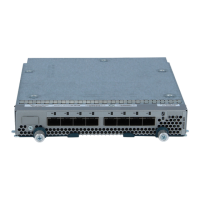half-width Cisco UCS B-Series Blade Servers and can accommodate both half- and full-width blade form
factors.
Up to four hot-swappable AC, DC or HVDC power supplies are accessible from the front of the chassis. These
power supplies can be configured to support nonredundant, N+1 redundant, and grid-redundant configurations.
The rear of the chassis contains eight hot-swappable fans, four power connectors (one per power supply), and
two I/O bays for I/O modules. A passive backplane provides support for up to 80 Gbps of I/O bandwidth to
each half-width blade and 160 Gbps of I/O bandwidth to each full width-blade.
Scalability is dependent on both hardware and software. For more information, see UCS 2104 to UCS 2200
Series FEX Upgrade Considerations, on page 77 and the appropriate UCS software release notes.
LEDs
LEDs on the chassis indicate system connectivity and failure warnings. See LED Locations, on page 35 for
details. There is also a flashing blue Beaconing LED and button that can be triggered manually or remotely
from UCS Manager.
Buttons
The beaconing function LED is also a feature on/off button. When triggered, beaconing of the server chassis
is observable remotely from UCS Manager.
Connectors
There are no user connectors such as RJ-45 ports on the chassis itself.
Midplane
The integral chassis midplane supports the following:
•
320 G total bandwidth to each of two I/O Modules
•
Auto-discover of all components
•
Redundant data and management paths
•
10 G Base-KR
The midplane is an entirely passive device.
Blade Servers
The Cisco UCS B-Series Blade Servers are based on industry-standard server technologies and provide the
following:
•
Up to two or four Intel multi-core processors, depending on the server
•
Front-accessible, hot-swappable hard drives or solid-state disk (SSD) drives
•
Depending on the server, support is available for up to three adapter card connections for up to 160 Gbps
of redundant I/O throughput
Cisco UCS 5108 Server Chassis Installation Guide
5
Overview
Blade Servers

